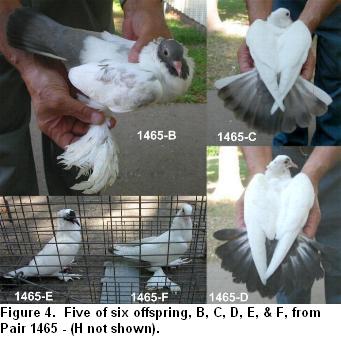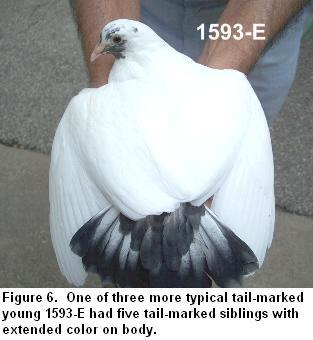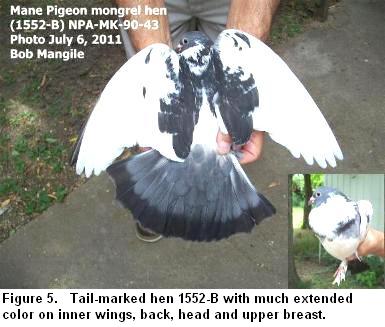
Trying to Understand the Inheritance of colored-tailed White Pigeons
by Robert J. Mangile
Introduction
The reason for this paper is to make available the data collected in breeding tests involving the Mane Pigeon (or Schmalkalden Moorhead) and recessive white Racing Homer. Trying to understand the inheritance of white plumage is fraught with difficulties. In Wendell M. Levis book, "Encyclopedia Of Pigeon Breeds" there are some pied patterns that are specific for a given breed, e.g., Magpie, Lahore, Helmet, Nun, Mane Pigeon and other Moorhead types. Mismarked examples occur, (e.g., colored wings/back in Mane Pigeons) and constant selection is required. Whether it is the instability and/or variability of the gene(s) that control these pied patterns has not been fully established. Of particular interest is that Levi fails to include "white" in the list of colors for these breeds but white is included in breeds that are saddle-marked, tail-marked, and other pied markings.
The initial goal of these tests, from 2005 to 2012, was to determine if a tail-marked or colored-tailed white plumage was the results of a single gene. The data from my tests did not confirm that to be true. Instead, the data indicates that the "tail-marked" white plumage is the result of at least two genes. More breeding data is needed.
Some History
As a boy in the early 1950's I had a free flying flock of mixed
pigeon breeds. A white King cock X black Nun hen mating produced one
white offspring with a mostly black tail. Later, the Nun hen
disappeared and her tail-marked daughter mated with her white King sire
and they produced another tail-marked young.
Explanations below are to help better understand this report.


A tail-marked F1 cock (1454-C) was mated to the Mane Pigeon daughter (Fig. 3) in Pair 1465 and produced six B1s, (Fig 4). All six had colored tails - as follows:
| Table 1. A list of 14 matings with tabulations of the number offspring and their plumage color. Birds from given matings are color-coded, e.g., pairings involving birds from Pair 1454 are blue, from 1524 are red, etc. Birds with various amounts of color extended on their body and wings (not head) are labeled with ext. | |||||||
| Pair No. |
Sire |
Dam |
Tail- Marked |
All White |
Self |
Pied Self
w/white in some flights and/or rump |
Total |
| 1454 |
Rec.
White Homer AU-98-RG-3479 |
Mane
Pigeon NPA-02-HC-786 |
3 A,B,C |
0 |
0 |
0 |
3 |
| 1465 |
Tail-marked 1454-C |
Mane
Pigeon NPA-83-ZL-384 |
6 (1 ext) |
0 |
0 |
0 |
6 |
| 1478 |
Tail-marked 1454-A |
Rec. White Homer IF-01-NAS-2238 |
3 |
1 |
0 |
0 |
4 |
| 1497 |
Tail-marked 1454-A |
Web-lethal Tpn T-748 |
0 |
0 |
2 A,B |
2 |
4 |
| 1504 |
Tail-marked 1454-C |
Dilute Check 1497-A |
1 |
4 |
5 |
2 |
12 |
| 1524 |
Tail-marked 1454-A |
Dilute Check 1497-B |
2 F,G |
1 |
1 |
2 |
6 |
| 1537 |
Tail-marked 1454-C |
Tail-marked 1524-F |
4 (2 ext) A,H |
0 |
0 |
0 |
4 |
| 1547 |
Tail-marked 1524-G |
Dilute Check Figurita NPA-83-DJ-337 |
0 |
0 |
3 |
3 |
6 |
| 1552 |
Tail-marked 1524-G |
(ext) Tail-marked 1537-A |
2 (2 ext) B,J |
3 |
0 |
0 |
5 |
| 1564 |
Tail-marked 1537-H |
Tail-marked 1524-F |
2 |
2 |
0 |
0 |
4 |
| 1583 |
Tail-marked 1524-G |
(ext) Tail-marked 1552-J |
9 (2 ext) |
0 |
0 |
0 |
9 |
| 1593 |
Tail-marked 1454-C |
(ext) Tail-marked 1552-B |
8 (5 ext) |
0 |
0 |
0 |
8 |
| 1617 |
Rec. White Homer AU-98-RG-3479 |
(ext) Tail-marked 1552-B |
7 |
0 |
0 |
0 |
7 |
| 1618 |
Rec. White Homer AU-87-TEXAS-0687 |
(ext) Tail-marked 1552-J |
2 |
0 |
0 |
0 |
2 |
Of the four offspring produced in Pair No. 1478, (Table 1)
involving an F1 tail-marked cock 1454-A and a recessive white hen,
three were tail-marked and one was solid white - the expected 3:1 ratio
for recessive white. The same F1 cock 1454-A paired to an unrelated
web-lethal (wl/.) T-pattern hen (1497) produced four offspring - two
non-pied dilute check hens (A & B) and two blues with pied flights.
Dilute check hen 1497-A was paired with an F1 cock 1454-C in Pair 1524
and dilute check hen 1497-B was paired with her F1 sire in Pair 1504.
These two pair produced a total of 18 offspring: 3 tail-marked, 5 solid
white, 6 self and 4 near self with a few white flights. Both mating
produced solid white offspring confirming that the dilute hens were
heterozygous for recessive white (zwh//zwh).


The only parings that failed to produce tail-marked or solid white
offspring involved unrelated self-color birds (1497 & 1547).
Discussion, Comments and Summation
The term "tail-marked" is generally understood to mean a white plumage with a colored tail but the amount of color in the tail can vary from a dark band across the distal end of a white tail to a full colored tail with colored tail coverts. Of the 49 birds classified as tail-marked in this report 35 were typically tail-marked some having colored feathers around their face and head, 14 had extended color on their body. All of the 10 parings (1478, 504, 1524, 1537, 1552, 1564, 1583, 1593, 1617, 1618) involving at least one recessive white and at least one typical or extended tail-marked parent in this line of birds produced tail-marked offspring of which five parings (1478, 504, 1524, 1552, 1564) produced solid white offspring. Though the numbers were small there seems to be some evidence that the tail-marked pied plumage in pigeons is heterozygous for recessive white (zwh//zwh). My research did not establish that tail-marked X tail-marked pairings breed true.
The black tail and black head on a white plumage in the Mane Pigeon appears to be a stable attainable pied pattern. John Epperson had 150+ Mane Pigeons that were all similarly marked. Their pied pattern is the result of either a directional selection of one gene's variability or is comprised of two or more pied factors. The white-sided bird in Figure 1 indicates partial dominance of white in the Mane Pigeon which blocks the pigmentation on the wings and body of the bird but allowing color on the head and tail. In 1552-B (Fig. 5) and 1465-B (Fig. 4) color begins to return to the wings and body.
Reviewing the data in this study generated more questions than conclusions. Would it have been possible to produce self-colored birds by continuous selection of birds with extended body color? Could any of the solid white birds produced be the result of compounded white factors instead of from homozygous recessive white (zwh//zwh)? Could the possible existence of any pied factors be sex-linked?
The Mane Pigeons stock used to start this project was not vigorous or fecund. The male died before a reciprocal cross could be made to a recessive white hen. There were no F1 females produced therefore no F2s were produced. Would F2s have provided better breeding data?
The three adult F1 cocks from Pair 1454 displayed noticeable partings in their neck feathers. There were no other record entries or recollections of crests or neck feather partings except in Pair 1465 backcrosses; however, all but a few were disposed of prior to molting in of adult plumage. Most were slipper footed with a few examples of muffs and featherless feet.
Of the 49 colored tailed birds produced "none" were self-colored (or approaching a self with only a few white flights) and eleven (11) were solid white. It is difficult to ignore the possibility of allelism of recessive white and a pied factor/gene in the Mane Pigeon. # # #